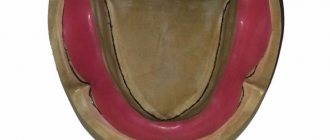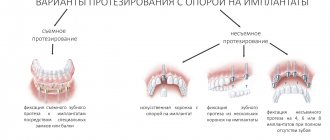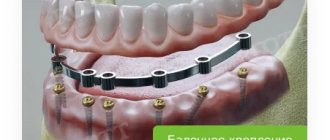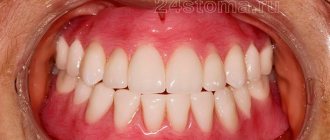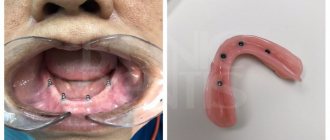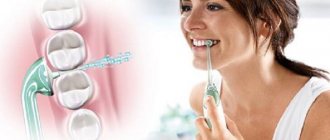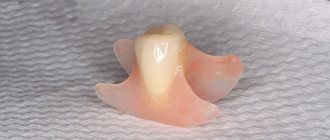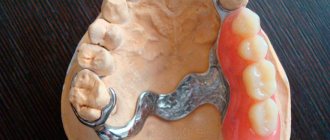From this article you will learn:
- types of fixed dentures on 4 implants,
- their cost, pros and cons,
- reviews on All-on-4 prosthetics.
The article was written by a practicing implantologist.
Dental prosthetics on 4 implants is an implantation technique that is used in the complete absence of teeth on the jaw and involves the installation of a permanent bridge prosthesis within the first 3 days after surgery. This technique was developed by the Swiss implant manufacturer Nobel-Biocare in 1998, and it is called All-on-4 (translated as “All on 4 implants”).
The surgical operation of installing 4 dental implants into the bone usually takes from 35 minutes to 1 hour, and then the prosthetic stage begins. The peculiarity of this technique is that at first your fixed prosthesis on 4 implants can only be temporary (i.e. adaptive). You will be able to use such a permanent prosthesis either for up to 5 months or for 2-3 years, which will depend on the design of the temporary prosthesis you choose and its cost. After this period, your temporary fixed prosthesis must be replaced with a permanent one.
Fixed denture on 4 implants –
As we said above, permanent All-on-4 prosthetics is carried out only in the second stage. If the patient has chosen an inexpensive option for a fixed temporary prosthesis (without a metal frame), permanent dental prosthetics All-on-4 is carried out after 5 months. If the temporary prosthesis was made on a metal frame, which greatly increases the cost of All-on-4, then re-prosthesis is carried out on average only after 2 years (maximum 3 years).
In this article we will talk about the features of temporary and permanent fixed dentures on 4 implants, and we will try to describe in simple words their differences from each other. You should also know that the cost of a temporary prosthesis will be included immediately in the price of All-on-4, but you will have to pay extra for a permanent prosthesis. The cost of dental prosthetics on 4 implants at the second stage will range from 150,000 to 550,000 rubles (depending on the type of permanent prosthesis).
All-on-4 prosthetic implantation scheme:
Implantation and prosthetics All-on-4 (methodology)
We talk in detail about the features of the surgical stage in another article, but in short, there are 2 options for the surgical technique. The first option is using an individual surgical template “NobelGuide”, thanks to which the installation of 4 implants will take the implant surgeon only 30-35 minutes. The second option is a classic technique without the use of a template, which requires incisions in the gums and large-scale detachment of mucoperiosteal flaps. Of course, the first option is preferable.
All-on-4 (implant installation stage) –
I would also like to dwell on the choice of implants for the All-on-4 technique, and by far the best choice would be to use original implants. This company has developed not only the “All-on-4” concept itself, but also special types of implants and abutments for it. We are talking primarily about the Nobel Speedy Groovy and Nobel Parallel CC implants, as well as aba (multi-unit), which today are the gold standard for permanent prosthetics of edentulous jaws.
Next we will look at:
- options for temporary fixed prostheses for All-on-4,
- options for permanent fixed dentures on 4 implants.
Options for dental prosthetics on implants
Removable
Ideal for people who have previously worn removable dentures. To adapt the removable structure to prosthetics on implants, laboratory specialists attach special latches (attachments) to it. This option reduces the patient’s financial costs, since there is no need to make a new prosthesis. Most often, removable dentures on implants are a transitional stage before the installation of permanent dentures.
Partially removable and fixed dental prosthetics on implants
Today, in the vast majority of cases, patients are given prostheses that are not removable. Partially removable products can only be removed by a specialist in the clinic.
Temporary fixed dentures on 4 implants –
Let's see how the temporary prosthetics stage is carried out. To do this, impressions of your jaws will be taken before surgery to make a complete removable denture from ordinary acrylic plastic. After the operation, a temporary prosthesis on 4 implants will be made from such a removable prosthesis. To do this, the excess volume of the plastic base and excess artificial teeth will be cut off from the removable denture (the temporary denture is usually short in length - 5 teeth inclusive).
Permanent fixed dentures on 4 implants are usually made in length - up to 6 teeth inclusive. However, temporary dentures are always made shorter in length in order to reduce the chewing load on the lateral implants (this is necessary during the period of their healing). In addition, a screw fixation system on implants is built into the temporary prosthesis, as well as an optional metal frame (Fig. 9-10). Thanks to this frame, the temporary prosthesis gains strength, and then it can be used for up to 3 years. But on the other hand, this will significantly increase the cost.
Converting a removable denture into a fixed bridge –
Thus, before concluding an agreement with the clinic, you will need to choose - 1) the manufacturer of dental implants, 2) the type of temporary fixed prosthesis, which can be either with or without a metal frame. The presence of a metal frame in the adaptive prosthesis significantly increases the cost of All-on-4.
- Example No. 1 – implantation according to the All-on-4 protocol for 400,000 rubles (the price includes the installation of 4 Swiss Nobel Biocare implants, multi-unit abutments, as well as a temporary adaptive bridge on a metal frame).
- Example No. 2 – implantation according to the All-on-4 protocol for 300,000 rubles (the price includes the installation of 4 Swiss Nobel Biocare implants, multi-unit abutments, as well as a temporary adaptive bridge without a metal frame).
1) Temporary bridge with metal frame –
This prosthesis option is the best not only because you can use it for up to 3 years (before you need a replacement prosthesis).
It must be remembered that a temporary fixed prosthesis will be made from a regular plastic removable denture, and by sawing off the excess plastic base from a removable denture, we further reduce its strength. The metal frame will give the temporary prosthesis high strength and reliability (Fig. 9-10). To install the frame, a piece of plastic is also cut out on the lower surface of the prosthesis - and a metal frame + a system for screw fixation of the prosthesis on implants is built in there. Embedding a metal frame into a prosthesis is a very complex and time-consuming procedure, which is why the presence of a frame in the prosthesis has such a big impact on the cost of the All-on-4. Thanks to the reinforced frame, the risk of breakage of such a prosthesis is minimal, and you can chew with it without fear.
2) Temporary bridge without frame –
If a temporary prosthesis with a metal frame is fixed to implants only for 2-3 days, then a prosthesis without a frame is fixed within a few hours after the operation. This is due to the ease of manufacturing of the latter. The main disadvantage of this version of the prosthesis is its low strength and, accordingly, reliability. Prostheses without a frame are not intended to be used for more than 5 months, and even during this not too long period there is a risk of breakage of such a prosthesis.
Let's see what types of patients would be contraindicated for a temporary bridge without a frame. Definitely not suitable for men under 50 years old, as well as patients with large jaws and well-developed masticatory muscles at any age. In addition, if you have bruxism (hypertonicity of the masticatory muscles), and here it should be noted that patients with bruxism are remarkably good at breaking dentures even with a metal frame (24stoma.ru). If you are going to chew something harder than porridge and rolled cutlets.
Definitely, the option of a prosthesis without a frame is not suitable for those patients who, due to work or other circumstances, may go to another city (for example, on vacation or a business trip). The fact is that if a prosthesis breaks down in another city, and you cannot immediately contact your implantologist, this is fraught with the loss of not only the prosthesis, but also all the implants. Therefore, a temporary bridge should ideally always be made with a reinforcing metal frame. The risk of breakage of a prosthesis without a frame will probably be minimal - only in women with small jaws.
Patients with temporary (adaptive) prostheses –
Clinical case No. 1 –
Clinical case No. 2 –
Care and maintenance of adaptive prostheses –
In addition to daily hygiene care using a irrigator, floss and toothbrush, your denture will require periodic professional maintenance. On average, once every 6 months (if oral hygiene is insufficient - once every 3 months) - you will have to go to the clinic for hygienic cleaning of the lower surface of the denture. To do this, the screws that secure the prosthesis to the implants will be unscrewed, and the prosthesis itself will be temporarily removed from the mouth.
Immediately after the procedure is completed, the prosthesis will again be fixed to the implants using screws. In addition, these screws will need to be replaced once a year (during every second procedure for professional hygiene of the prosthesis). Therefore, it is worth clarifying in advance whether professional servicing of the prosthesis is included in the list of free procedures under the warranty, and how much it will cost after the end of the warranty period.
Video of All-on-4 implantation and prosthetics:
* this video contains the stages of making a temporary (adaptation) bridge.
Types of structures
In general, implant-supported prostheses are divided into two types:
- Removable.
- Fixed.
The first type differs significantly from analogues of classical prosthetics. Traditional structures are fixed exclusively on the gums, or attached to supporting teeth. Thanks to implants, removable dentures are securely fixed in the jawbone, but they can be removed if necessary. That's why they are called conditionally removable.
Fixed dentures are considered a more durable and optimal option for dental restoration. In addition to the artificial crown, some types of structures are equipped with a base made of elastic plastic, which imitates natural gums.
Fixed dentures can be used to replace any number of teeth, even if they are located in different parts of the dentition. We will talk in more detail about each type of prosthesis a little later.
There are also temporary dentures that are installed during the period of fusion of the implants with the jawbone. They maintain the aesthetics of the dentition and reduce the mechanical load on the pins, speeding up the healing process.
Temporary dentures look like removable structures that hook onto supporting healthy teeth using hooks. The most common option is a butterfly-shaped prosthesis. It is equipped with a plastic gum and two plastic holders for adjacent teeth. A denture replaces one or more teeth in a row.
Permanent prosthetics All-on-4 – price and options
All-on-4 permanent dentures can be achieved with different types of permanent fixed dentures. There are a lot of options for permanent prostheses for All-on-4, and it is very difficult for an ordinary patient to understand all their subtleties and nuances. In addition, the choice of prosthesis is determined not only by your aesthetic requirements or financial capabilities, because... In a number of clinical situations, some types of prostheses simply cannot be manufactured.
In addition to the patient’s wishes, the choice of prosthesis will depend on the volume of space for prosthetics (the degree of vertical atrophy of the jaw bone tissue), as well as on the characteristics of the relationship between the upper and lower jaws. For a permanent fixed denture on 4 implants, the price in Moscow and Russia as a whole starts from 150,000 rubles, and this will be the most modest and not very reliable option for a permanent denture. It should be noted that in Russia, in order to reduce the cost of All-on-4, a number of clinics use materials and technologies that have long been abandoned in Europe due to their poor reliability.
Permanent denture options for All-on-4 –
We have already said several times that the All-on-4 technique was developed by Nobel-Biocare (Switzerland), including special types of implants and options for temporary and permanent dentures. In this section, we will first talk about the original options for permanent prosthetics that were developed by Nobel-Biocare, and then move on to a variety of options for prostheses (including non-original economy-class solutions specifically for Russia).
All types of original permanent fixed prostheses for All-on-4 can be divided into two large groups.
- Titanium-polymer prostheses - 90% of permanent prostheses for All-on-4 are made using this technology. Such a prosthesis has a supporting frame inside in the form of a titanium beam, individually manufactured for each patient - by milling on a computer-controlled machine (CAD/CAM technology). The outside of the beam is lined with acrylic plastic or ceramic composite, from which the base of the prosthesis (artificial gum) will be made + artificial teeth will be installed in the base of the prosthesis (Fig. 16-17).
If you are focused on quality, then it is better to choose original solutions - these are only titanium beams from Nobel-Procera, although non-original beams from other manufacturers can also be used (they will be a little cheaper). Modern beams are not made smooth - they have retention projections that act as supports for artificial teeth. The best option is probably the “NobelProcera hybrid beam”, which has no analogues from any company, not even Straumann.
But! Titanium-polymer prostheses require a lot of vertical space for prosthetics, and therefore, if the patient has only a slight degree of atrophy of the jaw bone tissue, these prostheses simply cannot be manufactured. In this case, we will offer the patient only bridges made of zirconium dioxide or metal ceramics.
- Bridges can be the familiar metal-ceramics or metal-free ceramics (zirconium dioxide). In both cases, the bridge frames will also be manufactured by milling using CAD/CAM technology. The original frame for a metal-ceramic bridge is made of titanium, the artificial teeth will be made of zirconium dioxide, and if artificial pink gum is needed, it will be made by applying a ceramic mass (Fig. 18).
The frame of the ceramic bridge will be made of zirconium dioxide, the artificial teeth will also be made of zirconium dioxide + if necessary, the prosthesis can also have pink artificial gum made of ceramic (Fig. 19). This is the best option for a prosthesis in terms of aesthetics, and in the photo below you can see how accurately it imitates the gums and teeth on the lower jaw, which are difficult to distinguish from real ones (Fig. 20).
Important: original All-on-4 prosthetics involves the use of only Nobel-Procera titanium bars and bridges. But it won’t be a problem if your clinic uses non-original milled frames made on similar equipment from other companies. But what’s really bad is when Russian dental clinics offer economical options for prosthetics, for example, when instead of a milled titanium beam, a cast beam made of nickel-chrome alloy is used. Or when metal-ceramics are made on a frame made of cobalt-chromium alloy (CHS), even by milling.
Such solutions make it possible to reduce the cost of All-on-4, but this reduces the strength of the prosthesis frame by at least 5 times, and in addition, the use of cast beams greatly impairs the accuracy of their fit on the installed implants. Another disadvantage is that cast nickel-chrome beams and CCS frames have a significantly greater mass (compared to titanium), which significantly increases the weight of the prosthesis and makes it difficult to get used to it.
Indications and contraindications for installation
An implant-supported prosthesis can restore one tooth, several adjacent units, or an entire row of teeth. However, the procedure involves surgery and therefore has a significant list of limitations.
Implantation is not performed if:
- poor clotting and other severe blood diseases;
- oncology;
- tuberculosis;
- connective tissue pathologies (lupus erythematosus, rheumatic disease, scleroderma);
- low level of immunity;
- inflammation of the mucous membranes of the mouth;
- problems with chewing muscles;
- mental disorders;
- diabetes mellitus in severe forms.
Temporary restrictions include jaw bone deficiency, dental diseases, addiction to alcohol, drugs, smoking, diseases of the nervous system, pregnancy, breastfeeding, and age under 18 years.
Permanent prosthesis on 4 implants – types and prices
We have already said above that 90% of all permanent fixed dentures on 4 implants are titanium-polymer dentures. They are made on the basis of a milled titanium beam, which will be lined on the outside with acrylic plastic or ceramic composite (this is a mixture of acrylic plastic and ceramic microparticles). Now we will look at the pros and cons of each type of prosthesis.
1) Acrylic prostheses with titanium bar –
A permanent fixed denture on 4 implants, made on a Nobel-Procera titanium bar, where artificial teeth and the base of the prosthesis will be made of acrylic plastic, will cost 370,000 rubles. The warranty for such a prosthesis is usually about 5 years, and its service life is more than 10 years. If a non-original titanium beam is used in the manufacture of the prosthesis, the price will be lower - from about 300,000 rubles. Photo of prostheses (Fig. 21-22).
2) Ceramic composite prostheses with a titanium bar –
This version of the prosthesis is similar to the previous one, but instead of acrylic plastic, a ceramic composite will be used, from which both artificial gums and artificial teeth will be made. If the prosthesis is made on the original Nobel Procera titanium beam, then its cost will be from 400,000 rubles. If a non-original titanium beam is used - about 340,000 rubles. The warranty for such a prosthesis is usually 5 years, the service life is more than 10 years.
It should be noted that, in fact, the service life of a titanium beam is lifelong, because it is almost impossible to break it. However, artificial teeth made of acrylic plastic or ceramic composite tend to gradually wear out, which will require reinstallation of artificial teeth in the prosthesis (replacing old artificial teeth with new ones is carried out on average once every 7 years).
Titanium-polymer prostheses –
Inexpensive alternative to titanium bar dentures:
Some clinics offer the following economical option for a permanent prosthesis. As a supporting frame, not a milled titanium beam will be used, but a beam made by casting from a nickel-chrome alloy. The artificial teeth and artificial pink gum will be made from acrylic plastic. For this option of a permanent denture on 4 implants, the price will be only from 180,000 to 200,000 rubles. If instead of acrylic plastic a ceramic composite is used - from 200,000 to 230,000 rubles.
The warranty on such prostheses is no more than two years, and their service life will be no more than 4-5 years. In no case should this type of prosthesis be made for patients with large jaws and well-defined masticatory muscles, patients with bruxism, and indeed all men under 50 years of age. The frame of such dentures has 5 times less strength (compared to titanium), and simply cannot withstand the chewing load and will burst. In addition, cast frames have a poor fit on the implants, which will mean a higher risk of developing inflammation around the implants.
3) Metal-ceramic bridge prosthesis –
This is a prosthesis option that is better not to do. The original version of such a bridge is made on a milled titanium frame, but it is worth saying that ceramics and titanium are far from the best combination of materials. Titanium gives the ceramics a gray tint, which greatly worsens the aesthetics of the prosthesis (anodizing the titanium frame can more or less solve this problem). Additionally, ceramics on a titanium framework have a higher risk of chipping, and dental technicians generally hate working with this combination of materials.
Another disadvantage of this version of the prosthesis is its very high price, and it will be cheaper to make a bridge from zirconium dioxide. However, there are situations when we can only make this version of the prosthesis. For example, when we need long side consoles for a prosthesis, and at the same time we do not have the opportunity to make a prosthesis on a titanium bar (due to lack of vertical space for prosthetics). But especially for Russia, there is a cheaper option for a metal-ceramic bridge with 4 implants.
In this case, the frame will be made by milling, but not from titanium, but from a cobalt-chromium alloy (CHS). Everything about this prosthesis is good, except for its weight and the presence of overhanging consoles in the prosthesis. The All-on-4 technique implies that the implants will be installed in the teeth position 5-2|2-5, which automatically means that the 6th teeth in the prosthesis are made in the form of overhanging consoles. When such consoles are made not of titanium, but of CHS, they are extremely unreliable and, accordingly, we have a high risk that their CHS frame may burst.
4) Zirconium dioxide bridge –
Of course, this is the most beautiful option for a permanent prosthesis on 4 implants. In this case, the milled frame of the bridge will be made of zirconium dioxide. The original frame is again “Nobel Procera”, but non-original “Prettau” types can also be used. Artificial teeth will also be made of zirconium dioxide using the milling method. The cost of such a prosthesis will be no less than 500,000 rubles. If the artificial teeth in such a prosthesis are made not from zirconium, but from Emax glass ceramics, then the cost will be no less than 550,000 rubles.
All-on-4 bridge made of Prettau ceramics –
The warranty on zirconia bridges is usually up to 10 years, but all ceramic bridges are certainly very expensive. The only more or less inexpensive option for metal-free ceramics is bridge-like prostheses using the Trinia technology (the frame of such prostheses is made of durable fiberglass, and the outside will already be lined with ceramic mass). The cost of the Trinia bridge will be about 250,000 rubles.
Important: if you decide to choose a bridge made of zirconium dioxide, then there are several nuances in the manufacture of the bridge that are important for the patient. It is important how exactly the artificial zirconium crowns will be made. Firstly, they can be made single, and secondly, they can be made in blocks (when several crowns are milled as a single unit). The second option is the best, and in this case the crowns are made in blocks - a block of 6 front teeth + two blocks, including 3 side teeth. Why is this so important?
The fact is that the first option involves many “seams” between the crowns, where pigments and, over time, bacteria will settle (the latter will lead in the distant future to the appearance of an odor from the prosthesis). But when we make artificial crowns in blocks, we have only 2 seams and, accordingly, we solve these problems. By the way, for the same reason, we do not recommend that you make a zirconium bridge in combination with Emax crowns, even if such prostheses have amazing aesthetics.
The fact is that Emax glass-ceramic crowns are made only single (they cannot be milled in the form of blocks with several crowns in each). And, accordingly, such a prosthesis will inevitably darken over time in the area of the seams between the artificial teeth, and an unpleasant odor will also appear. Therefore, the optimal manufacturing option is to use a zirconium dioxide frame in combination with zirconium crowns made in three blocks.
How does implantation work?
The main stages of the procedure are:
- Consultation and diagnosis. The specialist assesses the current condition of the patient’s oral cavity, takes an x-ray, and prescribes a series of tests to exclude contraindications to implantation. Also at this stage, the functioning of the temporomandibular joint, the state of the bite are assessed, and the parameters of the closure of the teeth and the movement of the lower jaw are recorded. This information is needed to create a comfortable prosthesis that will not overload the implants.
- Bone tissue augmentation (if indicated).
- Implantation.
- Dental prosthetics on implants.
You can find out how much dental prosthetics on implants costs from our managers.
Which prosthesis with 4 implants is better to choose?
The final choice of permanent fixed prosthesis design will depend on the following factors:
- on the volume of space for prosthetics,
- type of relationship between the upper and lower jaws,
- from the patient’s aesthetic needs,
- from financial capabilities.
If you want perfect aesthetics, then choose a zirconia bridge. Such a prosthesis will look most advantageous on the upper jaw, and if finances allow you, it is better to make such a prosthesis on the original NobelProcera zirconium frame; if you want to save money, use the Prettau frame. But it is worth noting that prostheses on a titanium beam using acrylic or ceramic composite also have quite decent aesthetics.
If you need to do implantation and All-on-4 prosthetics on two jaws at once, then a zirconium dioxide bridge can be made for only 1 jaw. Zirconium dioxide is a fairly hard material, and if both prostheses are made from this material, one of them will definitely burst within a few years. And in this case, a zirconium bridge is usually made on the upper jaw, and a titanium-polymer denture on the lower jaw.
Important : if you still have the opportunity, then do not settle for prostheses made on a cast frame made of ordinary nickel-chrome or on a milled frame made of CHS. This is just that extreme case when you simply cannot afford anything else. In this case, it is best to make a titanium-polymer prosthesis - even if on a non-original titanium beam. And if it’s expensive for you, then it’s better not to do All-on-4 at all. In this case, it is better to make a covering prosthesis on implants, which will cost you only from 120,000 to 150,000 rubles.
Reviews from patients 1 year after All-on-4:
Abutment selection.
They vary in type of manufacture and in the materials from which they are made. If you decide on the choice of a metal-ceramic crown, then a titanium abutment is quite suitable. If the crown is made without metal, from zirconium dioxide, then there are no options, only a zirconium abutment.
Regarding the question: standard or custom? Their cost varies, but not critically (individual is a little more expensive). BUT, the individual abutment is made with the utmost precision for the crown to fit to it, microgaps are eliminated, and pathogenic microbes will not enter the implant area. In the case of a standard one, there is a high probability that cement will get into the implant area already at the stage of fixing the crown, and subsequently microbes and bacteria will enter the implant area.
Maintenance and care of the prosthesis –
Permanent dentures All-on-4 require a very careful attitude. If you previously had a regular removable denture and cleaning it from plaque and food debris was quite simple, now your time spent on hygiene will immediately increase several times. Unfortunately, this comes at a price for the opportunity to have completely permanent dentures. The biggest difficulty is cleaning the underside of the denture.
A fixed denture does not “lie” on the gums, and between the gum and the lower surface of the denture there will be a rinsing space - where food debris will certainly fall. And, accordingly, with insufficient hygiene, plaque and tartar will be deposited on the lower surface of the denture. To prevent this, it will be necessary to regularly use an oral irrigator, as well as use special super-flosses. In addition, regular cleaning of the denture with a soft toothbrush will be required.
Professional denture maintenance – approximately once every 6 months you will have to visit the dental clinic for a professional cleaning session of the denture (for patients with poor hygiene – once every 3 months). To do this, the screws that secure the bridge to the implants are unscrewed, and the prosthesis is removed from the mouth. The lower surface of the prosthesis is professionally cleaned and polished, and then the prosthesis is again fixed to the implants using screws.
An important point is that the quality of hygiene of the lower surface of the prosthesis will depend not only on your efforts. When making a denture, a dental technician may make mistakes that may not allow the patient to clean the lower surface of the denture at all. Normally, the lower surface of the prosthesis should have a convex shape, but very often we see that the lower surface of the prosthesis is given a concave shape (Fig. 24-25) - it becomes impossible to clean such a surface with floss.
Therefore, patients with a concave shape of the lower surface of the prosthesis always have a large amount of tartar on the prosthesis, always have bad breath, as well as inflammation around the implants, which over time can lead to failure of all implants. But let's see what else you need. Patients with titanium-polymer dentures will have to replace artificial teeth in the denture approximately once every 7 years. The fact is that teeth made of acrylic plastic or ceramic composite gradually wear out (this happens especially strongly in the chewing areas).
Wearing of the chewing teeth will lead to a decrease in the height of the bite in the chewing sections and, accordingly, to an increase in the chewing load on the front teeth (which sooner or later will not withstand the load and will break).
Methods of implantation
One-stage dental prosthetics on implants
Immediately after removing the problematic tooth, an implant is implanted in its place, and, if there are no contraindications, a temporary crown is fixed on it. In some cases, installation is carried out within 7-10 days.
One-stage dental prosthetics on implants (with immediate loading)
Implantation of the implant and its loading with a temporary crown occurs in one stage. After the structure has healed (after 3-6 months), the temporary crown is replaced with a permanent one.
Two-stage dental prosthetics on implants (with delayed load)
At the first stage, the patient is given an implant and a plug is fixed to it. After the structure has taken root, a gum former is placed, after 7-10 days it is removed and an abutment is placed, on which a permanent crown is then fixed.
Care instructions
In order for implant-supported dentures to last as long as possible, they require careful care. Each patient receives written information about how to care for fixed or removable dentures after the procedure.
Special toothpastes and brushes are used to clean dentures. It is easier to take care of removable structures, because... You can easily remove the prosthesis. For this purpose, it is recommended to visit the dentist's office, who will professionally clean the dentures.
To remove food debris from interdental crevices and hard-to-reach places in the structure, you need to use dental floss, brushes and irrigators.
Remember, proper care of the prosthesis and careful use significantly extends its service life.

